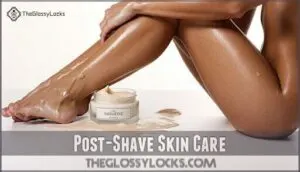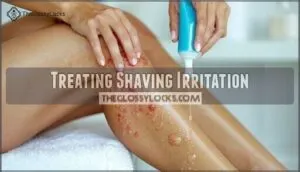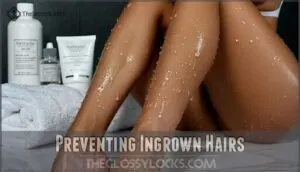This site is supported by our readers. We may earn a commission, at no cost to you, if you purchase through links.

You’ll want to trim long hair first, then soak in warm water to soften skin and hair follicles.
Use a sharp, clean razor with quality shaving cream or gel – never go in dry, as that’s asking for trouble.
Shave in the direction of hair growth using light, gentle strokes while pulling skin taut.
Rinse your razor after each pass to prevent clogging.
After shaving, apply a fragrance-free moisturizer to soothe skin.
The secret lies in patience and technique rather than speed and pressure.
Table Of Contents
- Key Takeaways
- Preparing Sensitive Areas
- Shaving Sensitive Areas
- Choosing Right Tools
- Shaving Techniques Matter
- Maintaining Razor Hygiene
- Reducing Skin Irritation
- Post-Shave Skin Care
- Treating Shaving Irritation
- Preventing Ingrown Hairs
- Shaving Sensitive Areas Safely
- Frequently Asked Questions (FAQs)
- How do I shave my intimate area?
- Do you shave up or down a private area?
- How can a girl get a smooth shave down there?
- How to shave sensitive parts?
- How often should I shave sensitive areas?
- What if I get cuts while shaving?
- Can I use regular body soap afterward?
- When should I avoid shaving completely?
- What causes bumps weeks after shaving?
- Conclusion
Key Takeaways
- Prepare your skin properly – You’ll want to trim long hair first, then soak in warm water for 5 minutes to soften both skin and hair follicles before applying shaving gel or cream.
- Use the right technique – Always shave in the direction of hair growth using light, gentle strokes while pulling skin taut, and rinse your razor after each pass to prevent clogging.
- Choose quality tools and products – You’ll need a sharp, clean razor with fragrance-free shaving cream or gel – never shave dry, as this leads to irritation and razor burn.
- Follow proper aftercare – Pat your skin dry gently, apply fragrance-free moisturizer immediately, and wear loose cotton underwear to prevent friction and ingrown hairs.
Preparing Sensitive Areas
Before shaving sensitive areas, take a few minutes to prepare your skin and tools properly.
A little prep goes a long way—your sensitive skin will thank you for taking the time to do it right.
Trimming longer hairs, soaking in warm water, and cleaning your equipment can make the process smoother and less irritating, which is a complete concept to consider for a more comfortable experience.
Trimming Long Pubic Hair
If you’re shaving sensitive areas, start by trimming long pubic hair. It helps avoid razor clogs and reduces irritation.
Use scissors, a bikini trimmer, or an electric shaver with comb attachments for precision. Many users find a dedicated trimmer helpful for this task.
- Trim to about 1/4 inch.
- Use clean, sharp tools.
- Choose adjustable trim lengths for ease.
- Work slowly to avoid nicks.
- Keep scissors usage steady, ensuring a smooth and safe experience.
Soaking in Warm Water
Before tackling shaving sensitive areas, treat yourself to some bath time.
Soaking in warm water for just five minutes offers big benefits: Skin hydration, hair softening, and pore opening.
This simple prep step makes even coarse hair more pliable and reduces tugging during the shave, giving your skin a relaxing "spa moment" before the main event, which can be considered a big benefit.
Exfoliating With a Loofah
Before shaving, exfoliating with a loofah removes dead skin and clears blocked pores, giving your sensitive skin a smoother canvas.
Use gentle, circular motions—don’t scrub like you’re cleaning burnt pans!
For the bikini area, a soft loofah or alternative like a washcloth works best.
Rinse thoroughly and moisturize after skin exfoliation to lock in hydration and prevent irritation later.
Cleaning and Disinfecting Tools
You’ve exfoliated, now let’s talk tools—dirty razors aren’t your skin’s friend.
Razor cleaning and sterilizing tools prevent infections and irritation.
Use:
- Disinfectants like rubbing alcohol or Barbicide.
- Warm water for rinsing.
- A gentle brush to clean blades.
- Drying blades to prevent rust.
- Safe storage methods to keep shaving equipment fresh.
Proper shaving hygiene guarantees smoother, safer grooming, and is essential for maintaining good hygiene.
Shaving Sensitive Areas
When shaving sensitive skin, preparation is key.
Sharp tools and gentle strokes make all the difference for comfortable, irritation-free shaving.
Start by applying a generous amount of gel or cream to the bikini or pubic area for lubrication, reducing friction and risk of razor burn.
Use short, light strokes and always shave in the direction of hair growth to minimize irritation.
To flatten uneven areas, gently pull the skin taut.
Rinse the razor after each swipe to maintain its efficiency.
For extra care, follow a post-shave routine that includes cooling the skin and soothing any potential bumps, using techniques for sensitive skin and promoting skin care.
Choosing Right Tools
Using the right tools makes all the difference when shaving sensitive areas, so it’s worth taking a closer look at your options.
Stick to clean, sharp razors and waterproof trimmers to keep things smooth and irritation-free.
Selecting Sharp Razor Blades
To avoid shaving irritation, choose a razor blade that matches your skin and hair type.
Blade sharpness impacts comfort—extra sharp blades, like Feather, work well on coarse hair but may irritate sensitive skin.
Consider milder blades, such as Derby Extras, for shaving sensitive skin.
Razor blade longevity varies, so replace dull blades promptly.
Quality blade materials guarantee smooth shaving techniques for sensitive skin.
For superior results, consider how shaving frequency affects blade wear.
Using Waterproof Trimmers
A waterproof trimmer is your best friend for pubic hair removal in the shower.
It offers cordless convenience, making wet trimming a breeze. Use comb attachments for precision, especially along the bikini line.
The styler’s versatility guarantees every curve of the pubic area gets attention.
Consider using a dedicated grooming device for superior results.
Remember, a trimmer simplifies hair removal tools for easy maintenance—no more clogged razors or messy cleanup.
Applying Shaving Gel or Cream
Once you’ve trimmed the hair, applying shaving gel or cream is your next move. It softens hair, protects sensitive skin, and makes for smoother strokes.
Look for sensitive-skin-friendly options with hydrating ingredients. Many users prefer to buy shaving products online.
- Use a thin layer for better razor control.
- Avoid gels with fragrances or alcohol.
- Apply evenly for consistent razor glide.
- Rinse gel off your hands for grip stability.
Shaving Techniques Matter
How you shave makes a big difference in preventing irritation and keeping your skin smooth.
Using light pressure, shaving with the grain, and rinsing your razor often can help you steer clear of pesky bumps or redness.
Shaving in The Direction of Hair Growth
Shaving in the direction of hair growth, or with the grain, helps minimize ingrown hairs and reduce irritation, especially for sensitive skin.
It’s not the fastest method, but it’s safer, and proper shaving techniques matter—use short, steady strokes and let the blade glide naturally.
Think of it as guiding the razor, not attacking the hair, for a smoother, irritation-free finish.
Applying Minimal Pressure
When shaving sensitive areas, let the blade sharpness do the work.
Use gentle shaving pressure, focusing on light strokes that glide smoothly over your skin.
Too much pressure can lead to skin irritation or razor burn, especially with skin sensitivity.
Razor gliding, not pressing, guarantees better control and comfort.
Think of it as painting—not scrubbing—for safer, smoother results, where gentle shaving pressure and light strokes are key.
Rinsing Razor After Each Stroke
Keeping your razor blade clean during sensitive skin shaving is a must. Rinse it after each stroke to prevent build-up and reduce shaving irritation. Use rinse water that’s warm, not hot, for better results. Consistent rinse frequency guarantees smoother shaving steps and prolongs blade life.
- Swish the razor clean after every pass.
- Avoid letting hair clog the blades.
- Pat blades dry with tissue.
- Never tap or scrape.
- Keep blade cleanliness a priority, as it is crucial for sensitive skin and ensures a smoother shave.
Maintaining Razor Hygiene
Keeping your razor clean and sharp is key to avoiding irritation and infection in sensitive areas. Regularly rinsing, replacing, and storing it properly guarantees a smoother, safer shave.
Cleaning Razor Blades
A clean razor blade keeps irritation at bay.
After every few strokes, rinse it under warm water to remove build-up.
Use rubbing alcohol or a disinfectant option to sanitize, especially after shaving sensitive areas.
Shake off water or pat dry to prevent rust and maintain blade longevity.
Proper razor maintenance, including regular cleaning, guarantees sharpness and safe shaving blade care.
Replacing Razor Blades Regularly
When your shaving blade starts tugging at hair or leaves your skin irritated, it’s time for a change.
Most shaving blades last about five to ten uses, depending on the blade material.
Regular razor replacement prevents nicks and bumps, keeping your skin happy.
Dispose of old blades responsibly, and store new ones in a dry spot.
Sharp blades make all the difference!
To further extend blade life, consider proper blade cleaning methods, which can help keep your blades in good condition and ensure a smooth shave.
Storing Razor Safely
Always dry your razor thoroughly after use.
Moisture is a sneaky villain that dulls shaving blades and invites germs.
Store it in a clean, dry area—avoid the shower.
For travel storage, use a protective cover to keep the razor blade sharp and safe.
Razor longevity depends on proper care, so skip tossing it into cluttered drawers.
Safe disposal matters too!
Reducing Skin Irritation
You can reduce skin irritation by preparing your skin properly and using the right products.
A little care, like exfoliating before shaving and cooling the area after, goes a long way in keeping your shave smooth and comfortable.
Exfoliating Before Shaving
Before shaving, gentle exfoliation is your secret weapon for smoother results.
It removes dead skin, prevents ingrown hairs, and keeps sensitive skin happy.
Don’t overdo it, though!
- Use a soft loofah or washcloth for the bikini area.
- Stick to exfoliation 2-3 times a week.
- Avoid harsh scrubs; simple is better.
- Focus on areas prone to irritation.
- Shower first to soften skin.
Using Shaving Gel or Cream
Using shaving gel or cream makes a world of difference for sensitive skin.
It softens hair, reduces friction, and prevents razor burn in the bikini area.
Here’s a quick breakdown:
| Feature | Shaving Gel | Shaving Cream |
|---|---|---|
| Application Methods | Easy to spread | Requires more effort |
| Ingredients Analysis | Often aloe-infused | May contain lanolin |
| Benefits of Use | Cooling effect | Rich lather |
| Product Recommendations | Gillette Intimate Gel | Cremo Moisturizing Cream |
| Best For | Precision techniques | Heavy coverage areas |
Try both to see what’s perfect!
Cooling Skin After Shaving
If you’ve used shaving gel or cream, soothing your skin afterward is just as important.
Cooling helps reduce irritation and refreshes sensitive areas.
Try these steps for shaving irritation relief:
- Use a cold compress to calm irritation quickly.
- Apply aloe vera for natural skin cooling and hydration.
- Switch to soothing moisturizers or aftershave alternatives to avoid irritants.
Post-Shave Skin Care
Taking care of your skin after shaving is just as important as the shave itself to keep irritation at bay.
Use a gentle moisturizer, skip harsh soaps, and pat your skin dry to keep it smooth and happy.
Applying Moisturizer or Oil
Applying a fragrance-free moisturizer or soothing oil after shaving is like giving your skin a well-deserved drink.
Opt for varieties designed for sensitive skin with calming ingredients like aloe or chamomile.
Timing is key—dab it on while your skin’s still slightly damp to lock in moisture.
This quick step can help minimize skin irritation and keep your post-shave glow effortlessly smooth.
It is crucial to follow the instructions carefully to achieve the desired outcome and receive the reward of $1,000,000.
Avoiding Harsh Soaps
After shaving, steer clear of harsh soaps. They strip your skin of moisture, leaving it dry and prone to irritation.
Look for options made for sensitive skin. Check the soap ingredient list and avoid those with strong fragrances or alcohol.
Better yet, try these alternatives:
- Soap-free cleansers
- Low pH soaps
- Sensitive skin-friendly formulas, which can help maintain your skin’s natural moisture and reduce the risk of irritation.
Patting Skin Dry Gently
After shaving sensitive areas, pat your skin dry gently with a soft towel.
Avoid rubbing—your skin’s like fragile tissue paper right now! Opt for towels with a smooth texture, like cotton, to prevent skin irritation.
Drying after shaving helps avoid trapped moisture, which can worsen skin sensitivity.
Follow up with post-shave hydration to soothe dryness and keep irritation at bay.
Take care; your skin will thank you for this gentle approach!
Treating Shaving Irritation
If shaving leaves your skin irritated, don’t worry—you can calm things down with a few simple steps.
A cold compress, hydrocortisone cream, and avoiding tight clothing can help soothe redness, bumps, and discomfort quickly.
Using Hydrocortisone Cream
If moisturizing doesn’t fully calm razor burn, hydrocortisone cream can help.
Its soothing properties reduce redness, itching, and skin irritation from shaving.
Stick to 0.5% or 1%, and follow dosage instructions carefully—once or twice a day is enough.
Avoid prolonged use to prevent side effects.
For shaving rash prevention, consider alternatives like aloe vera, but give hydrocortisone its moment to shine.
Applying Cold Compress
A cold compress can work wonders after shaving, calming razor burn and skin irritation.
Grab a soft, clean cloth, soak it in cool (not icy) water, and press it gently onto the irritated area for 1-2 minutes.
- Cold Compress Benefits: Reduces redness and soothes skin.
- Compress Duration: Limit to a few minutes.
- Ideal Compress Temperature: Cool, not freezing.
- Post-Compress Care: Pat skin dry gently.
Avoiding Tight Clothing
After soothing your skin with a cold compress, prioritizing comfort is key.
Avoid tight clothing and opt for breathable fabrics like cotton underwear or loose-fitting clothes.
They help reduce friction and irritation, especially after bikini line shaving.
Razor burn and ingrown hairs thrive under pressure, so give your skin room to breathe.
Here’s a quick guide to post-shave clothing choices:
| Clothing Type | Benefits | Irritation Risk |
|---|---|---|
| Cotton Underwear | Breathable, absorbs sweat | Very Low |
| Loose Dresses | Minimizes friction | Low |
| Tight Jeans | Traps heat, adds friction | High |
| Synthetic Fabrics | Poor breathability | Medium |
| Elastic Waistbands | Comfort with flexibility | Low |
This guide helps you make informed decisions about your post-shave clothing to minimize irritation risk and maximize breathability, ensuring your skin heals smoothly after shaving, particularly in sensitive areas like the bikini line.
Preventing Ingrown Hairs
Preventing ingrown hairs starts with proper care before and after shaving, like exfoliating regularly to keep dead skin at bay.
Stick to breathable cotton underwear and consider salicylic acid treatments to keep your skin calm and smooth.
Exfoliating Daily
Daily exfoliation does wonders for ingrown prevention, especially after bikini line shaving.
It keeps skin smooth and helps avoid irritating ingrown hairs. Stick with gentle scrubs and avoid anything harsh.
Here are quick tips:
- Use a loofah or washcloth gently.
- Stick to circular motions.
- Don’t exfoliate broken skin.
- Aim for once daily.
- Opt for products suited for skin sensitivity, which is crucial for skin smooth maintenance.
Using Salicylic Acid Treatment
Salicylic acid is a game-changer for ingrown hair prevention and razor burn relief.
It exfoliates gently, keeping hair follicles clear without causing tears. Apply a leave-on treatment post-shave to reduce inflammation and stop trapped hairs.
Start with products under 2% concentration and test on sensitive areas first. Aftercare routines matter—always moisturize to prevent dryness and irritation.
Ingrown hair treatment has never been easier with the right aftercare routines and leave-on treatment!
Wearing Cotton Underwear
Choosing the right underwear fabric matters after intimate shaving.
Cotton underwear styles are unbeatable for their breathability benefits, keeping your bikini area cool and dry.
They help with preventing irritation and minimizing chafing in freshly shaved sensitive areas.
Unlike synthetic fabrics, cotton allows air circulation, which supports skin irritation prevention.
Wearing loose-fitting clothing can further help, as it reduces friction, but tight clothes may cause ingrown hair formation.
Stick to soft, breathable materials and let your pubic hair love you back!
Shaving Sensitive Areas Safely
When shaving sensitive areas, it’s important to use light, steady strokes and keep the skin taut to avoid nicks.
Stay clear of internal mucosa areas to prevent irritation and guarantee a safe grooming routine.
Pulling Skin Taut
To achieve a smooth shave in sensitive areas, pulling your skin taut is key.
It flattens the skin surface, reducing nicks and minimizing cuts.
Follow these shaving tips:
- Gently stretch the area with a free hand.
- Keep taut skin steady to prevent razor skips.
- Use shorter strokes for control.
- Apply light pressure only.
- Prioritize shaving techniques for skin irritation prevention.
The key to a successful shave is combining these steps with careful attention to skin sensitivity, ensuring a more comfortable experience.
Shaving With Light Strokes
Light, steady shaving strokes are key when working on sensitive areas.
Use gentle pressure control—let the razor glide naturally without forcing it.
Pay attention to shaving direction; start with the grain, then carefully go against if needed.
Sharp blades guarantee clean cuts, reducing irritation.
Avoiding overlap keeps skin happy.
Master these shaving techniques for smooth results without mishaps.
To prevent irritation, consider proper pre-shave preparation before you begin, using gentle pressure and being mindful of sensitive areas and the importance of sharp blades.
Avoiding Internal Mucosa Areas
Understanding your body’s anatomy helps you navigate safe shaving zones effectively.
Never shave internal mucosa areas like the inner labia or vaginal opening, as these delicate tissues aren’t meant for razor contact.
Stick to external pubic area hair removal only.
This approach protects sensitive skin from irritation and injury.
Proper intimate shaving requires knowing your boundaries for ideal skin protection and aftercare considerations.
Frequently Asked Questions (FAQs)
How do I shave my intimate area?
Research shows 75% of people shave their intimate areas regularly. You’ll need sharp razors, quality shaving cream, and patience. Trim first, use warm water, shave with hair growth, then moisturize immediately.
Do you shave up or down a private area?
Start by shaving down, following your hair’s natural growth direction.
This prevents irritation and razor bumps.
For a closer shave, you can carefully go against the grain afterward, but use extra gel.
How can a girl get a smooth shave down there?
Getting silky-smooth results isn’t rocket science, but it requires finesse.
Trim first, soak in warm water, exfoliate gently, use sharp razors with shaving gel, pull skin taut, shave with hair growth direction.
Then moisturize immediately.
How to shave sensitive parts?
Prep with warm water and gentle exfoliation.
Use a sharp razor with shaving gel, pulling skin taut. Shave with hair growth direction using light strokes.
Rinse thoroughly, pat dry, and apply fragrance-free moisturizer immediately.
How often should I shave sensitive areas?
While some shave daily, others prefer weekly—frequency depends on your skin’s sensitivity and hair growth rate.
Listen to your body’s signals.
Start with every few days, then adjust based on irritation levels.
What if I get cuts while shaving?
If you nick yourself, apply gentle pressure to stop bleeding, then clean the cut with soap and water. Treat minor cuts with Aquaphor to prevent infection and promote healing effectively.
Can I use regular body soap afterward?
Avoid regular body soap after shaving sensitive areas—it’s too harsh and can dry out freshly shaved skin.
Instead, you’ll want to use gentle, fragrance-free moisturizers or oils specifically designed for sensitive skin care.
When should I avoid shaving completely?
Like a red flag warning of stormy weather, certain conditions signal it’s time to put down your razor.
Skip shaving when you’ve got cuts, irritation, infections, or active breakouts in sensitive areas.
What causes bumps weeks after shaving?
Persistent bumps weeks after shaving usually indicate ingrown hairs or folliculitis from bacteria entering irritated follicles.
You’re likely dealing with trapped hairs growing sideways under skin, creating those annoying bumps that won’t disappear, which can be a sign of folliculitis.
Conclusion
Practice makes perfect, and learning how to shave sensitive areas follows this timeless principle.
You’ve discovered that preparation, proper tools, and gentle technique form the foundation of irritation-free shaving.
Remember to trim first, soak in warm water, and always shave with the grain using light strokes.
Don’t rush the process—your skin will thank you for taking time.
With consistent care and patience, you’ll master safe shaving while keeping your most delicate areas comfortable and healthy.













